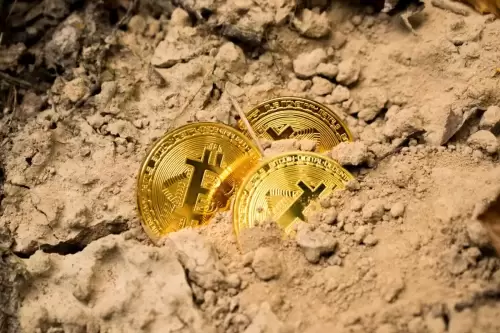 |
|
 |
|
 |
|
 |
|
 |
|
 |
|
 |
|
 |
|
 |
|
 |
|
 |
|
 |
|
 |
|
 |
|
 |
|
Cryptocurrency News Articles
Bitcoin Solaris: Quantum-Secured Mobile Mining Protocol Targeting Smartphones
May 14, 2025 at 06:00 pm
Bitcoin Solaris takes the next step forward with a quantum-secured mobile mining protocol, integrating quantum-resistant hashing techniques into a decentralized architecture that also supports low-resource smartphone mining.

Litecoin was designed to improve on Bitcoin's limitations with faster blocks and a memory-hard hashing algorithm - Scrypt - to deter ASIC domination. While it succeeded in democratizing mining temporarily, it was never designed to resist emerging threats like quantum computing.
As quantum processing capabilities edge closer to real-world viability, cryptographic protocols relying on classical hash assumptions face obsolescence. Bitcoin Solaris takes the next step forward with a quantum-secured mobile mining protocol, integrating quantum-resistant hashing techniques into a decentralized architecture that also supports low-resource smartphone mining. It's the first implementation to combine practical post-quantum protection with on-device earning, closing the gap between theoretical cryptography and real-world user engagement.
A Dual-Layer Protocol Reinforced Against Quantum Attacks
Bitcoin Solaris uses a dual-layer blockchain to isolate functions and maximize both security and performance:
This framework prevents key recovery, hash collisions, and transaction forgery under both classical and post-quantum attack models. It represents a fundamental departure from algorithms like Scrypt, which - while computationally demanding - remain vulnerable to Grover's and Shor's algorithms once quantum processing becomes practical.
Mobile Mining Secured for the Long Term
At the user level, Bitcoin Solaris enables mining through the Nova App, which transforms smartphones into passive income devices. Unlike Scrypt-based systems that require dedicated hardware and produce diminishing returns over time, the Nova App uses background CPU and storage - secured by post-quantum verification logic - to issue daily BTC-S token rewards.
Each mining interaction is validated through secure timestamping and Merkle-root commitments, ensuring that even if mobile devices are targeted by future computing threats, reward issuance and ledger participation remain tamper-proof.
In a recent post, Crypto Volt compares Bitcoin Solaris's mobile mining approach to Litecoin's Scrypt model - highlighting where traditional proof-of-work falls short and how quantum-secure hashing changes the game for long-term miners.
Presale Phase 3: Early Entry Before Full Quantum Protocol Deployment
Bitcoin Solaris is now in Presale Phase 3, with BTC-S priced at $3 USDT. This phase grants access before quantum-secured validator logic and full mobile mining distribution go live across the ecosystem.
Out of the 21 million BTC-S fixed supply, 4.2 million tokens (20%) are allocated to presale. With no inflation and no algorithmic token generation beyond validated participation, early users benefit from low-cost access ahead of a network built to scale under both classical and quantum-secure conditions.
Third-Party Audits Confirm Quantum-Ready Design
Bitcoin Solaris's quantum security and mobile mining logic have undergone independent evaluation:
These audits ensure the protocol's design remains secure not just today, but in the cryptographic landscape of the next decade.
Litecoin's Scrypt algorithm was a critical innovation in its time - but Bitcoin Solaris builds for the future. With quantum-secure validation, post-quantum encryption, and mobile mining that rewards users daily without hardware, it offers a forward-compatible foundation for secure, decentralized participation. As presale access continues and protocol expansion begins, Bitcoin Solaris is proving that the next generation of mining is already here - and quantum ready.
Disclaimer:info@kdj.com
The information provided is not trading advice. kdj.com does not assume any responsibility for any investments made based on the information provided in this article. Cryptocurrencies are highly volatile and it is highly recommended that you invest with caution after thorough research!
If you believe that the content used on this website infringes your copyright, please contact us immediately (info@kdj.com) and we will delete it promptly.
-

-

-

-

- A Bull Market's Like a Crypto Block Party - Jump in Early, Scoop Profits, and Bounce Before the Dip Crashes the Vibe
- May 14, 2025 at 11:20 pm
- Bull markets spike coins like Solana, Ethereum, and Bitcoin, fueled by hype, ETF inflows, or halvenings. I got hooked after dropping $80 on Solana during a 2024 rally
-

-

-

-

-



















![[Market 5.13] BTC continues to play music and dance? #btc #ETH #sol #doge [Market 5.13] BTC continues to play music and dance? #btc #ETH #sol #doge](/uploads/2025/05/14/cryptocurrencies-news/videos/market-btc-continues-play-music-dance-btc-eth-sol-doge/image_500_375.webp)




![[Ronnie Trading Guide]-2025.5.14-Notice: Bitcoin will test the previous high soon~ wait and see~ [Ronnie Trading Guide]-2025.5.14-Notice: Bitcoin will test the previous high soon~ wait and see~](/uploads/2025/05/14/cryptocurrencies-news/videos/ronnie-trading-guidenotice-bitcoin-test-previous-wait/image_500_375.webp)





































